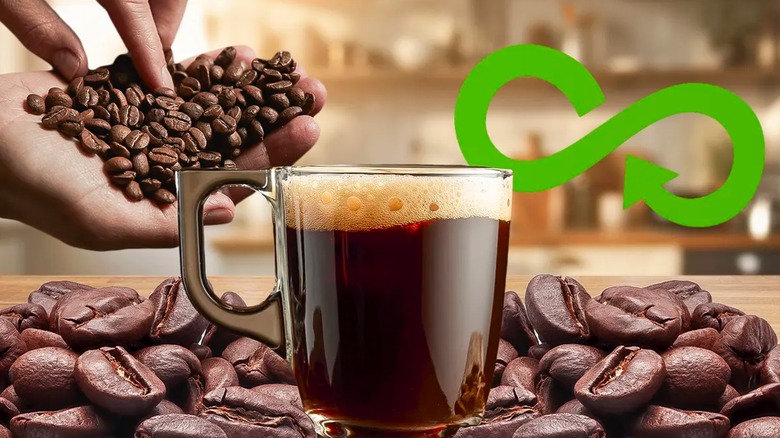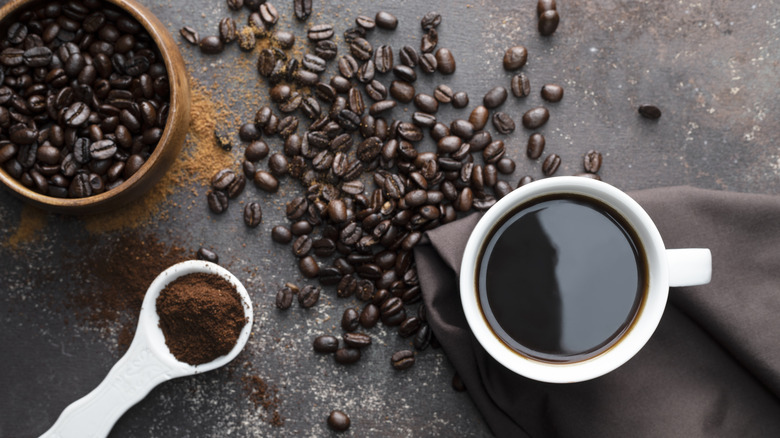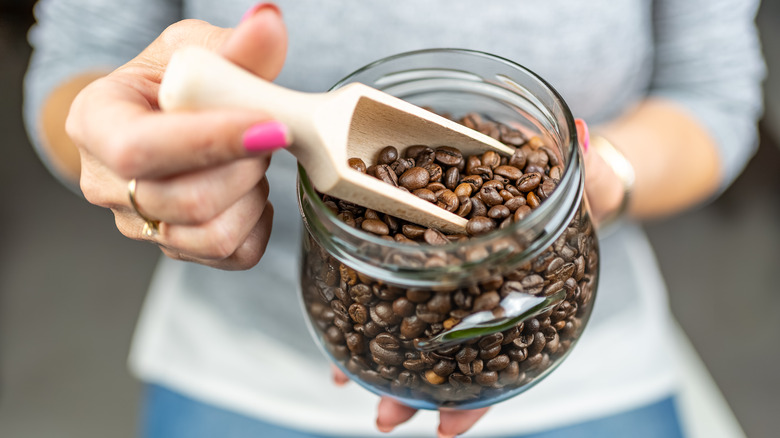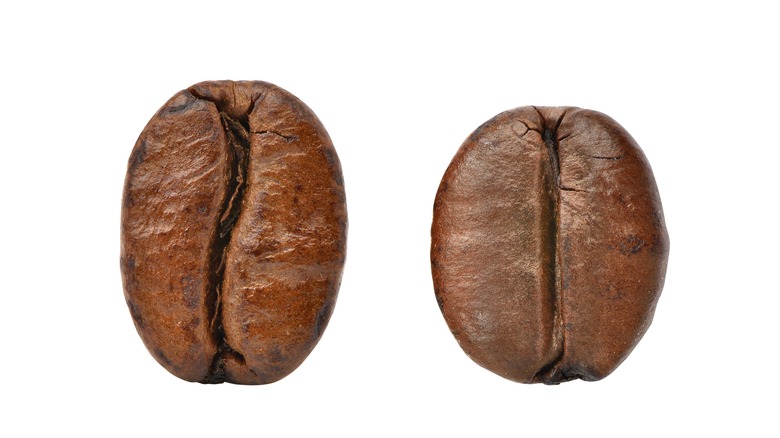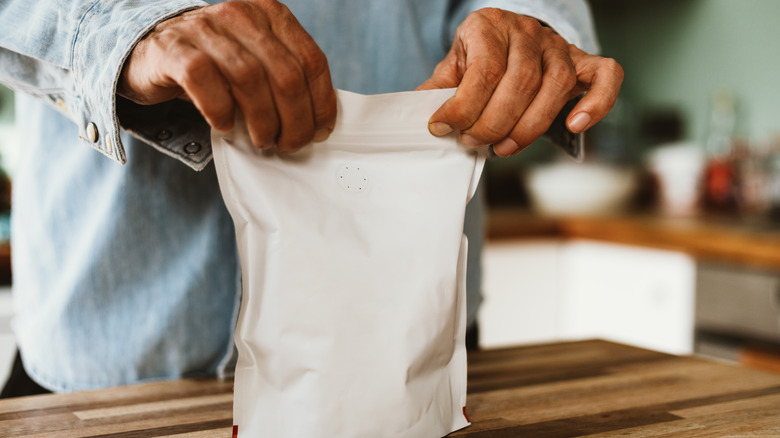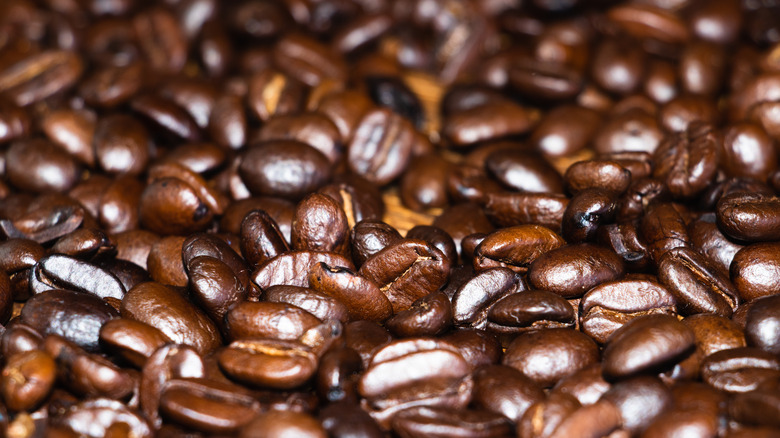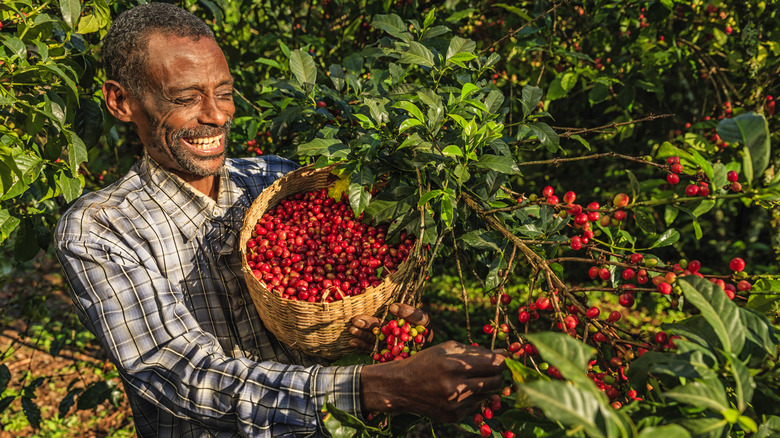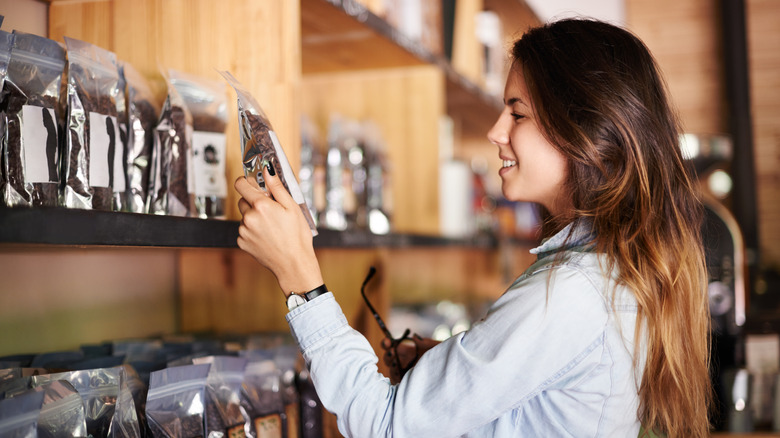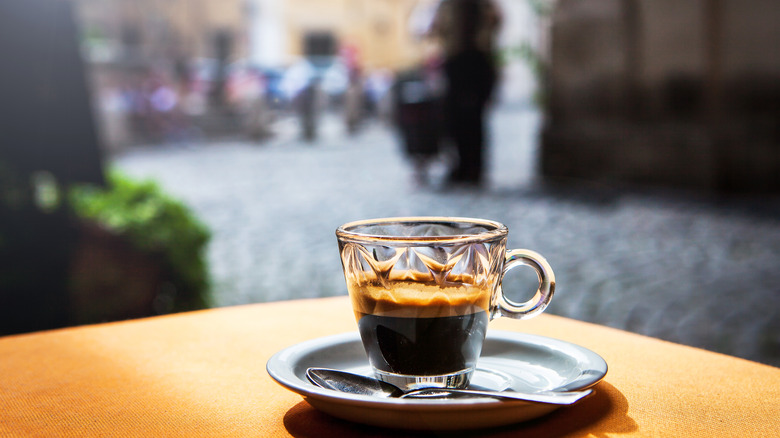9 Tips For Picking Espresso Beans Like A Pro
While popping into your favorite coffee shop to order a latté, Americano, or cappuccino is convenient, there's nothing like brewing your own café creation from the comfort of home. While most of us are experts at brewing regular coffee at home, espresso is a whole new ball game. Espresso has a richer, more bitter flavor profile than black coffee, and it's absolutely necessary to craft most of your favorite café drinks. The process of brewing this beloved wake-up requires significantly more time, patience, and finesse, but the lengthy prep and brewing time is worth it for those exquisite lattés and cappuccinos that give us the strength to dominate each day.
Making espresso at home can be daunting; choosing the right espresso machine and the best tamper for your machine — along with other tools for your home coffee arsenal — is no small feat. However, of all the necessary components for great home-brewed espresso, the paramount ingredient is the coffee beans. Type, source, flavor profile, and roast level all play a significant role in how your espresso tastes, which ultimately determines the quality of your handcrafted coffee concoctions. When it comes to picking beans, the number of options is almost too much to bear, even for seasoned coffee experts. I've used my years of barista experience and coffee expertise to craft this list of tips so you can narrow down your bean choices and master the most crucial choice when making espresso at home.
The darker, the better
Anyone that's ever sipped on espresso wouldn't be surprised to learn that dark-roasted beans are typically used in its creation. The drink is known for its bitterness and rich, dark color, and that's partially thanks to those dark beans. Dark roasted coffee is also ideal for cappuccinos and lattés. The thick texture and decadent, chocolatey taste of dark coffee pairs better with milk, sugar, and syrups, allowing every flavor to shine in your homemade drinks.
Espresso can be crafted using lighter roasts, but this is typically done by expert baristas looking to expand their coffee palette and create unique beverages. Lighter roasts typically don't do well with milk. They're known to be fruity-tasting and higher in acidity than dark roasts, and these flavors can make the milk in a drink taste sour. For those new to the espresso world who are practicing brewing at home, dark roasts are much more forgiving and versatile. So even if your espresso extraction is poor due to the wrong grind size or tamping methods, dark beans ensure that your drink retains the classic, robust espresso taste, whereas the use of a lighter roast would highlight any mistakes made in the home-brewed espresso-making process.
Opt for whole beans
If you plan to make your own espresso at home, I say go big and make your coffee from scratch the whole way through. Grinding whole beans makes a fresher-tasting espresso. As soon as coffee is ground, it begins to degrade in freshness and flavor, so keeping your beans intact before brewing holds all those precious, delicate flavor notes in so you can experience them in full force in your first morning cup. Whole beans also keep for significantly longer than pre-ground coffee, which can start to decline in flavor and quality in as little as three days.
In order to grind fresh, whole bean coffee at home, you'll need a coffee grinder. A good quality coffee grinder is essential to get your espresso to the specific grind size needed for a proper extraction. Espresso needs to be finely ground — but not too fine — and this is only achievable with grinders that are designed to grind coffee for the purpose of making espresso. Choose a burr grinder — as opposed to a blade grinder — for an even, consistent grind and a delicious shot of espresso to follow.
Choose a local roaster
An easy way to narrow down your coffee choices and guarantee a superb espresso is to choose locally roasted beans. For those new to crafting exceptional homemade coffee, a visit to your local neighborhood coffee roaster can completely change the course of this exciting hobby. Choose from a variety of whole bean coffees, from expertly curated blends to top-tier single origins, while having any questions about brewing espresso answered by friendly and knowledgeable staff. Choosing to shop local is a great way to support your community and make a positive economic impact.
Large coffee companies usually focus their efforts on maintaining consistency and keeping costs low, while local roasters aim to create exciting new, high-quality products to entice their passionate customer base. Whole beans from these roasters are typically higher in quality and roasted in small batches, yielding a superior product to what you'd find at a grocery chain or large online retailer. Once you familiarize yourself with your new favorite coffee company — whether it's your closest neighborhood roaster or the best coffee roaster in your state — get to know the staff and products and prepare for an adventure in the coffee realm.
Decide what taste profile you're after
Once you have the espresso-making process down pat, it's time to experiment with different coffee beans to create the espresso of your dreams. Different beans and blends offer specific flavor notes, bodies, and aromas. First, consider what your espresso will be used for; whether you're attempting to create a cappuccino to rival those of Italy's finest cafés or you want to enjoy your espresso black to savor every nuanced flavor and taste profile in its natural form. Impart your personal taste preferences into your home-brewed espresso to give your coffee an essence of creative individuality.
For those who prefer floral and berry notes in their espresso or coffee drinks, an arabica coffee is the best choice. Arabica coffee — the world's most popular coffee — is grown at high altitudes and is defined by its light, sweet taste and delicate balance of flavors. This coffee is ideal for those who drink espresso black or prefer dry cappuccinos.
Robusta coffee, on the other hand, is true to its name, delivering a robust, earthy flavor to espresso and café drinks. Robusta is the most common choice for instant coffee for its ability to add rich, nutty flavor with ease while being less expensive. If you aim to make milky lattes or want to add a shot of powerful espresso to drip coffee, robusta beans make flavorful sweet drinks and add depth to red eyes.
Consider when you'll use the beans
Although it's hard to imagine coffee beans going bad, they do have a limited shelf life. Once they're past their prime, they won't likely make you sick, but they'll noticeably degrade in flavor and quality. There are multiple ways coffee lovers attempt to keep coffee beans fresh longer, including sticking them in the freezer or keeping them in an airtight jar out of direct light. But the best way to ensure that your coffee always tastes its best is to choose whole beans and use them as soon as possible while keeping moisture, light, and air far away.
If you plan to keep your beans unopened for longer than a few weeks, opt for beans that are nitrogen-flushed as opposed to vacuum-sealed. When coffee beans are packaged using nitrogen-flushing, oxygen is expelled from the bag and replaced with nitrogen, which doesn't react with the coffee's taste or texture and keeps the beans fresh. Vacuum-sealed coffee lasts for months unopened as well, but some oxygen will always be present in the bag. Whichever of the two coffee-preservation methods are used in your bag of beans, be sure to use the coffee within 10 days of opening it.
Steer clear of oily beans if you use a superautomatic machine
Greasy beans look unappealing, but they're actually some of the best beans to make a quality espresso. The oils in dark roasted beans indicate a rich crema and the potential for nuanced smoky flavors. However, oily beans aren't suitable for some espresso machines.
Most superautomatic espresso machines include a grinder and frother, so that all you need to do to make a delicious drink is add whole beans, water, and milk and watch the magic happen before your eyes. In recent years, espresso-making technology has advanced to make fully automatic machines more desirable and easy to have at home. As these machines gain traction, noting their differences from other machines is important to avoid damaging your shiny, new coffee-making toy.
Oily beans leave traces of their oil behind in espresso makers, which for some just requires a quick cleaning to preserve the life of the machine. Superautomatic machines, however, can't be taken apart to clean. These oils collect in the machine's grinder and eventually destroy the machine. So before you settle on your first bag of coffee beans to use in your new fully automatic espresso maker, inspect them and make sure they're on the drier side.
Consider ethics and sustainability
These days, consumers are growing more conscious of the environmental and socio-economic impacts of their purchasing choices. Coffee is high on the list of potentially unethical items flooding the consumer market. Some coffees are produced using unfair treatment and compensation to workers while contributing to the degradation of the environment, while other coffees are certified fair trade and come from companies that disclose the coffee's environmental impact. Knowing where your coffee comes from is the first step in ensuring a proper espresso drink.
Choosing coffee that aligns with your personal morals and values is a great way to feel good about what you buy and obtain a superior product to boot. When it comes to most products, you get what you pay for, and this certainly stands true for coffee. Compared to regular coffee, fair trade certified coffee is usually more expensive, but this price difference reflects higher quality, ultimately leading to a more delicious espresso. The price of fair trade coffee also reflects fairly compensated workers and the cost of obtaining certifications that let customers know that the coffee comes from a company that cares about its employees and the environment.
Decide whether you want a blend or single-origin coffee for your espresso
Another element to consider when choosing a bag of specialty espresso beans is whether you want a blend or single-origin coffee. Blends incorporate coffee beans from multiple sources and are typically designed for specific uses, like to enhance particular flavors or to create a balanced brew. Blends are ideal for beginners to the world of espresso by offering greater consistency and balance than single-origin coffees. Since blends are designed to create specific, balanced flavor profiles, they're more forgiving taste-wise if any mistakes are made during extraction. Chances are, your favorite café's to-die-for espresso is a blend, and some of the most sought-after beans for making a delicious home-brewed espresso are blends.
Alternatively, single-origin coffees are becoming increasingly popular for use in espresso, especially among experienced coffee fanatics. Single-origins are less likely to be balanced and more likely to have small defects in flavor and consistency. Although this seems unappealing for espresso, some baristas are up for the challenge. They enjoy working with single-origins in order to hone their coffee-making skills and brew espresso with unique flavor notes and natural nuances. Knowing exactly where the coffee comes from allows baristas to familiarize themselves with the particular flavors of coffee from specific regions, allowing for more precise experimentation.
For beginners, Italian robusta beans are best
If you just got your hands on your first espresso machine and are itching to start experimenting with different blends, roast levels, and flavor profiles, I'd suggest you start with the basics first. Learn to brew excellent espresso by working with a coffee that's known to produce an excellent shot even if some mistakes are made and your extraction isn't up to snuff.
Italian robusta coffee produces the quintessential espresso — think of a hearty dark roast that's as black as midnight on a moonless night. This espresso is topped with rich, frothy crema that forms naturally and with ease in an Italian robusta coffee. Be sure to opt for an espresso blend to ensure a proper espresso drink. Italian espresso blends usually contain arabica coffee as well as robusta, but the elements of robusta that make Italian espresso some of the best in the world really shine in these blends. From here, you can easily experiment with crema and different extraction techniques. Once your skills are down pat, then it's time to get your hands on a single-origin, or some lighter roasts, and start crafting drinks that showcases your newfound talents.
